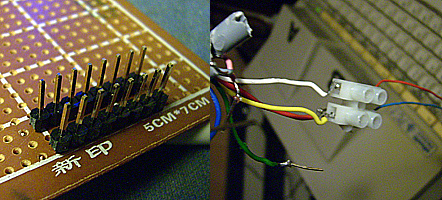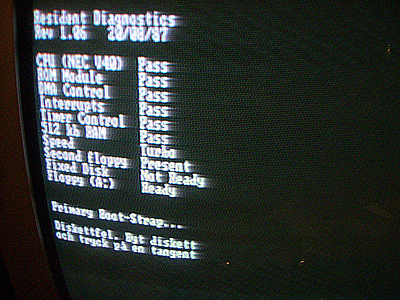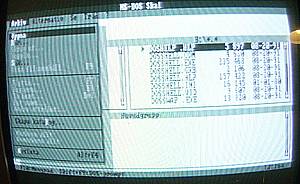RetroChallenge Winter Warm-Up 2014
Why change a .. ehrm, not winning concept? Just like last year, I'm entering
the RetroChallenge
Winter Warm-Up without any particular, ongoing task. Eventually I'll get
preoccupied with one thing until I get stuck, and then I'll have to decide
what to do instead...
Examples of tasks I am likely to spend my time on
- Rearrange my relatively small collection of (games) software. Lately
I have seen dozens of vlogs featuring various collectors who have their stuff
arranged nicely and kept together. I have stuff a little everywhere, including
a few drawers full of boxes that just as well could be showcased in a shelf.
- Go through two huge boxes of 5.25" floppy disks that a friend donated
in the fall of 2013. The vast majority are for the Atari 8-bit computers, but
some appear to be of the C64/128 variety. At least I'll try to catalogue some
of them to know what is worth keeping.
- A bit more programming here and there. I got stuck with VDP timing on my
Creativision Reversi game last year, which I should've settled by now but
haven't gotten around to do.
- My IBM RT hasn't been up to much action since I last powered it on, about
January 7, 2013 as far as I can tell. I still need to see if I can get it to
communicate with the rest of the world, e.g. through a dumb serial connection.
- Investigate why my Apple II to IBM PC joystick adapter doesn't register
fire buttons. Actually I modified the design to accept auto-fire joysticks,
which only caused the adapter to work even worse than before. Perhaps I used
bad parts, wired them backwards or the design I found is not the correct one.
- Various other troubleshooting and fix projects. New candidate since last
year is that my only working ZX Spectrum 48K no longer is working, after I
tried to add a brand new joystick interface. I don't have a lot of hope that
I'll be able to fix it within this time frame, but who knows?
- December 30, 09:50 (GMT+1)
Project defined and early preparations. - January 5, 23:00 (GMT+1)
What a busy week! To this point, I got virtually nothing
done on my RetroChallenge projects. I've measured some of my shelves, but
not done any rearranging of those yet.
I brought up the two big boxes of floppy disks and just counted through
those. With no intent to load anything yet, and as many of them already are
documented what they should contain, I had a soft start just counting them.
The total is that apart from my "own" collection of 5.25" floppy disks,
a measly 100 or so, I'm now in possession of another
506 disks. The vast
majority are home copied for the Atari 8-bit computers, but some appear to be
for the C64 as well.
Actually there are a few original floppy disks in the lot as well, but only
as loose disks with sleeve and some with instruction leaflet. This is the list,
of which I don't think either are particularly rare ones. Unless otherwise
specified, those are C64/128 disks:
- Breakout Construction Kit (*)
- Cauldron II
- Commodore 128 CP/M System Disk, CP/M Plus Version 3.0
- Commodore 1570/1571 Test/Demo
- DOS 2.5 (Atari Corp, might be more of those)
- Ferrari Formula One
- Fortress Underground (German edition)
- Giga Cad System (64'er)
- Glider Pilot
- Golden Games - Software made in Germany (Eckhart & Gehrmann Gbr)
- Grand Prix 500cc
- Monaco Super Fahrsimulator und weitere (*)
- Ninja Collection: Double Dragon
- Ninja Collection: Dragon Ninja
- Ninja Collection: Shadow Warriors
- Power Boat USA
- Pro Powerboat
- Saboteur (Elite Thrill Time, Gold vol. 2) - seems overwritten
- Savage
- Space Pilot Compendium (German edition)
- Starray (*)
- Teenage Mutant Hero Turtles
- Teenage Mutant Hero Turtles (different label)
- The Real Ghostbusters, Bit Star edition (*)
- Turrican II und weitere (*)
- Voyager (Rex Datentechnik)
The ones marked with an asterisk (*) are those I'm not certain they qualify as
original disks, or just well made copies.
Apart from floppy disks, I also found one LensLok device and two Philips
Professional digital cassettes, model LDB 4301 certified for 1600 FRI. I think
those have stronger magnetizing than regular audio cassettes, but I haven't
yet found out what the FRI acronym represents.
Oh well, perhaps the following week will make me reach more progress on the
various small tasks. At least I should try to load some of those 500+ floppy
disks, in particular those lacking a label with an index. I suppose I should
try each disk first in a 1050, then a 1541 and finally a PC to see if either
of them can read it. - January 12, 00:40 (GMT+1)
Not much happening here. The other night I tried to solder up
a composite video cable for my Olivetti PC-1. While the pinout for the 8-pin
DIN has been posted, it is unclear how the pins were numbered by the person
who submitted the pinout. I tried all the obvious and less obvious combinations
without much success. At one combination, I got a black screen with some pixels
of garbage, which might be due to I combined sync and ground into a composite
signal.
Currently I'm out of 8-pin DIN connectors to harvest, so I might have to
order one from China. None of the local shops carry that kind of stuff and if
I have to mail order, I might as well mail order at affordable prices.
The reason why I want composite video output instead of using the CGA output
on the PC-1, is that I hope some of the games that use the NTSC composite video
mode on the CGA will work on the Olivetti too, although it is not an US model.
Perhaps I'm doing it in vain, time will tell.
Update: I found a domestic reseller with lower prices for small
volumes than the sellers in far Asia, so I'm hopefully getting parts a bit
sooner. - January 15, 01:05 (GMT+1)
So the items I ordered on the night to Sunday arrived on
Tuesday, thanks to finding a domestic reseller.

My initial idea was to solder up some kind of jumper board, with one lead
for each pin from the 8-pin DIN going to the middle of the jumper board, and
then the outer rows joined to signal and ground respectively on a RCA
connector.
While I managed to put it together, it was a rather tight fit, I was short
on jumpers and the middle row after a while let go. Thus I reverted back to the
terminal block solution, which is not as elegant but I often get to work.

After some fiddling, I found that the yellow lead must be the ground, and
the white pin carries the composite video.
Yay! Now to figure out what yellow and white means in terms of pinout. It
should be pointed out the connector actually is a 262 degree "horseshoe"
connector, same as on the C64/128, Sega Genesis/Megadrive and others. I had
not checked this prior to ordering connectors, but fortunately I ordered both
the 262 and 270 degree variants, and in the end found that the 270 degree one
kind of works if you carefully bend the two outer pins a bit outwards.
Anyway, the posted pinout looks like this:
| Pin | Function | Connector |
|---|
| 1 | Blue video |

Male |
| 2 | Green video |
| 3 | Red video |
| 4 | Ground |
| 5 | Sync |

Female |
| 6 | Unknown |
| 7 | Composite video |
| 8 | Function switching |
Now, my yellow lead (ground) is connected to pin 4 according to the
graphic to the left, and the white lead (composite video) goes to pin 6.
Apparently the given pinout does not match the standard numbering. At first I
figured perhaps the numbering refers to the female connector, or male connector
seen from the solder side but then it would be pins 5 + 7, not 4 + 7.
Perhaps I'll try an analog RGB connection as well, to sort the
other pins, although composite video was my primary goal. As seen from the
above pictures, my cable still is in a temporary state but that will be solved
later on.

Update: It turns out this composite video is B&W. One could argue
perhaps it outputs NTSC video and you're in PAL land, but this TV perfectly fine
displays NTSC composite video in colour both from my Nintendo Famicom and an US
VIC-20.
Oh well, perhaps I'll not have a lot of fun with it anyway,
except for the satisfaction to figure out the pinout itself.
|




